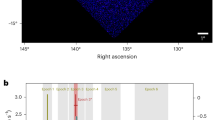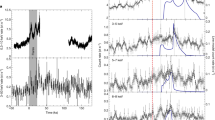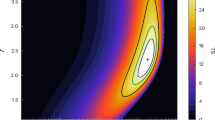Abstract
AT least 20% of all Type I Seyfert galaxies are detectable1,2 (at the comparable Ariel 5 and Uhuru sensitivities) as X-ray sources in the ∼2–10 keV band. Both the Ariel 5 and Uhuru results indicate the X-ray luminosity function is quite steep (dN/dL∼L−2) so that more sensitive HEAO X-ray detectors may reveal that nearly all Type I Seyfert galaxies are X-ray sources. It is suggested here that the diffuse background spectrum observed at hard X-ray and γ-ray energies can be accounted for by Seyferts, given their individual (hard) spectra.
Similar content being viewed by others
Article PDF
References
Elvis, M. et al. Mon. Not. R. astr. Soc. (submitted).
Tananbaum, H., Peters, G., Forman, W., Giacconi, R. & Jones, C. Astrophys. J. (submitted).
Ricker, G. et al. Astrophys. J. Lett. (submitted).
Schwartz, D. & Gursky, H. in X-ray Astronomy (eds Giacconi, R. & Gursky, H.) 359 (Reidel, Dordrecht, 1974).
Baity, W., Jones, T., Wheaton, W. & Peterson, L. Astrophys. J. Lett. 199, L5–L8 (1975).
Di Cocco, G. et al. Nature 270, 319–320 (1977).
Hall, R., Meegan, C., Walraven, G., Djuth, F. & Haymes, R. Astrophys. J. 210, 631–641 (1976).
Schnopper, H. W., Epstein, A., Delvaille, J. P., Tucker, W., Doxsey, R. & Jernigan, G. Astrophys. J. Lett. 215, L7–L11 (1977).
Apparao, K. et al. IAU Circ. No. 3150 (1977).
Maraschi, L. et al. Nature 272, 679–681 (1978).
Hermsen, W. et al. Nature 269, 494–495 (1977).
Grindlay, J. E. Astrophys. J. 199, 49–53 (1975).
Fichtel, C., Simpson, G. & Thompson, D. Astrophys. J. (submitted).
Author information
Authors and Affiliations
Rights and permissions
About this article
Cite this article
GRINDLAY, J. Diffuse γ-ray background from Seyfert galaxies. Nature 273, 211 (1978). https://doi.org/10.1038/273211a0
Received:
Accepted:
Issue date:
DOI: https://doi.org/10.1038/273211a0
This article is cited by
-
Active galaxies and the diffuse γ-ray background
Nature (1983)
-
Origin of MeV-excess in the energy spectrum of diffuse cosmic γ rays
Nature (1978)



